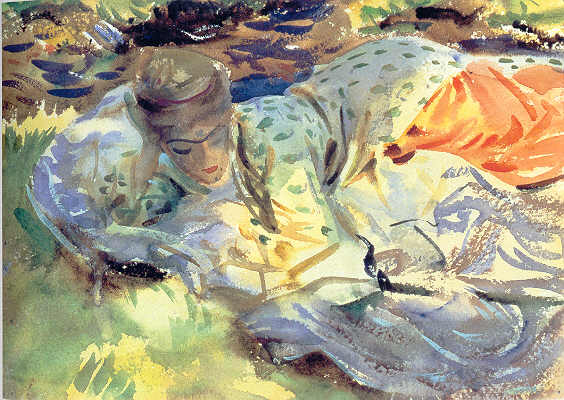  |
  |
|
# Accession Number: 09.847 Purchased by Special Subscription Zuleika (zoo-LAY-ka) is of Persian and indirectly biblical origins with the meaning: "Brilliant Beauty". Though the name is never directly used in the bible, it appeared in later retellings of the story of Joseph and is meant to be the wife of Joseph's employer "Potiphar" - the Captain of the Bodyguards to the Pharaoh of Egypt. The Egyptian's wife continually, though unsuccessfully, temps Joseph with seduction (Genesis 39:1-20). Then later in the Qur'an the same story is retold with different names (Chapter 12:21-35). The actual name "Zuleika"
arrives
in the middle ages from Persian epic poems and the Jewish stories of
Sefer
Hayashar which was first published in Venice in 1625. Zuleika's
passion,
in these expanded stories, herself a great beauty, leads to a suicidal
state of depression. All of this is very interesting, but the source of Sargent's title is more likely prompted by his very good friend, the humorist Max Beerbohm whom was writing, around this time, his one and only novel by the name of "Zuleika Dobson". The title of Max's book was an obvious literary allusion to the old Persian poems. He sets his story, however, in contemporary times (1910's). Zuleika Dobson is an arresting beauty who visits her grandfather at Oxford who happens to be the Warden of Judas College. The minute she steps off the train, every undergraduate falls in love with her -- literally. Led by the very eligible and handsome Duke of Dorset, the entire class of under grads pledge their collective suicide as an extravagant gesture of their love for her -- hundreds of them -- and they do it. Believe it or not this book is a comedy, and I've even seen it listed (today) as one of the hundred greatest English novels. It's essentially a farce of Oxford life and nobility. The book was over thirteen years in the making and even though it didn't first go to print until 1911, John and Max were palling around London well before 1907 and certainly during that year. Elizabeth Oustinoff, in
her chapter
"The Critical Response" (Sargent Abroad) makes the point that
this
was probably an inside joke to Max. After all, the artist had to come
up
with hundreds of painting titles. With Max having drawn a number of
humorous
jabs at Sargent made public in caricatures; Sargent, has a chance to
make
a public nod back to his friend -- in a form that only Max would
understand.
That others would eventually get it -- but only later when the book was
finally published -- would be the joke from Sargent.
Notes:
Often Sargent didn't title a painting until it either sold or was exhibited. If that's what happened in this case, it may have been less than a year before the publication of Max's book. If that's the case, the chances are even higher of Sargent knowing of Max's manuscript. See the Project Gutenberg's Zuleika Dobson by Max Beerbohm Exhibitions Sargent in Italy, 2002-2003
|